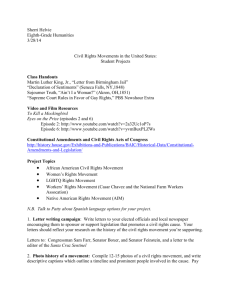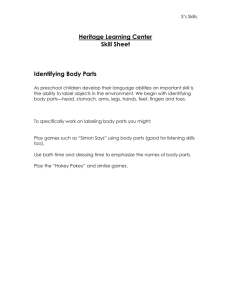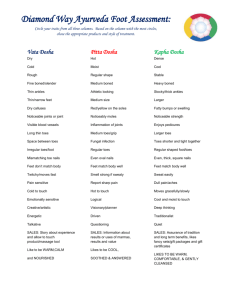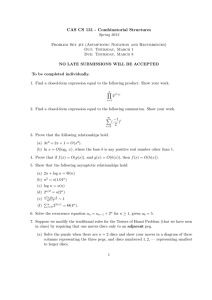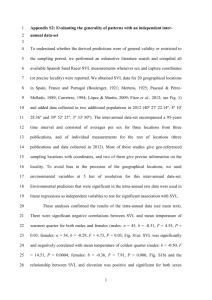RESEARCH COMMUNICATIONS H
advertisement
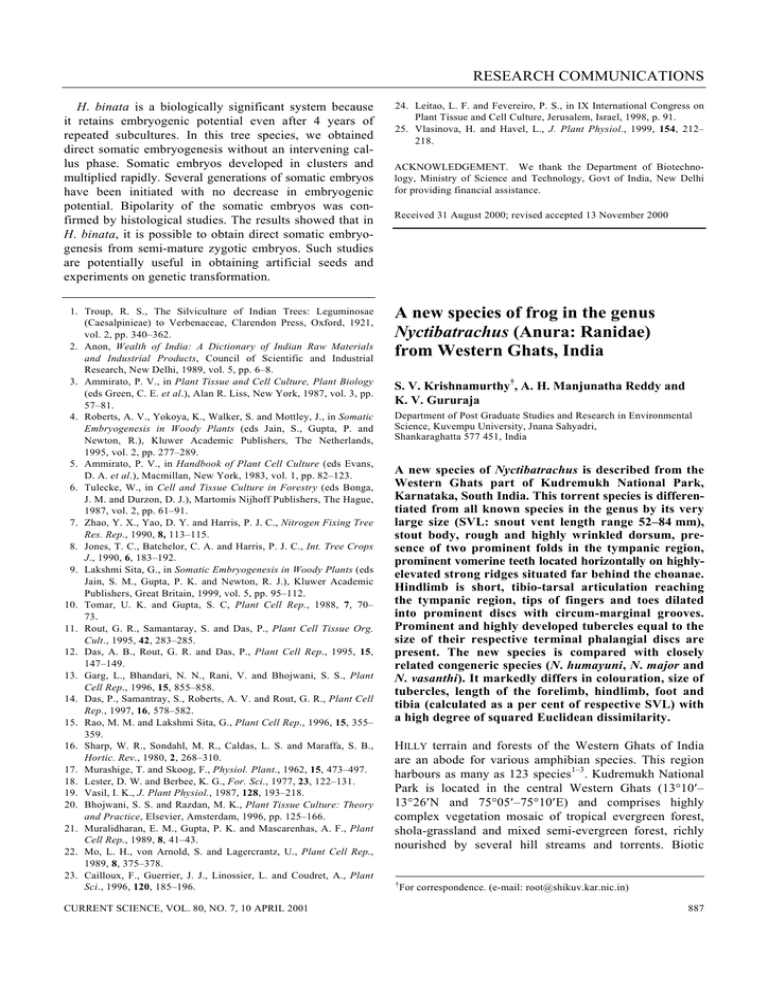
RESEARCH COMMUNICATIONS H. binata is a biologically significant system because it retains embryogenic potential even after 4 years of repeated subcultures. In this tree species, we obtained direct somatic embryogenesis without an intervening callus phase. Somatic embryos developed in clusters and multiplied rapidly. Several generations of somatic embryos have been initiated with no decrease in embryogenic potential. Bipolarity of the somatic embryos was confirmed by histological studies. The results showed that in H. binata, it is possible to obtain direct somatic embryogenesis from semi-mature zygotic embryos. Such studies are potentially useful in obtaining artificial seeds and experiments on genetic transformation. 1. Troup, R. S., The Silviculture of Indian Trees: Leguminosae (Caesalpinieae) to Verbenaceae, Clarendon Press, Oxford, 1921, vol. 2, pp. 340–362. 2. Anon, Wealth of India: A Dictionary of Indian Raw Materials and Industrial Products, Council of Scientific and Industrial Research, New Delhi, 1989, vol. 5, pp. 6–8. 3. Ammirato, P. V., in Plant Tissue and Cell Culture, Plant Biology (eds Green, C. E. et al.), Alan R. Liss, New York, 1987, vol. 3, pp. 57–81. 4. Roberts, A. V., Yokoya, K., Walker, S. and Mottley, J., in Somatic Embryogenesis in Woody Plants (eds Jain, S., Gupta, P. and Newton, R.), Kluwer Academic Publishers, The Netherlands, 1995, vol. 2, pp. 277–289. 5. Ammirato, P. V., in Handbook of Plant Cell Culture (eds Evans, D. A. et al.), Macmillan, New York, 1983, vol. 1, pp. 82–123. 6. Tulecke, W., in Cell and Tissue Culture in Forestry (eds Bonga, J. M. and Durzon, D. J.), Martomis Nijhoff Publishers, The Hague, 1987, vol. 2, pp. 61–91. 7. Zhao, Y. X., Yao, D. Y. and Harris, P. J. C., Nitrogen Fixing Tree Res. Rep., 1990, 8, 113–115. 8. Jones, T. C., Batchelor, C. A. and Harris, P. J. C., Int. Tree Crops J., 1990, 6, 183–192. 9. Lakshmi Sita, G., in Somatic Embryogenesis in Woody Plants (eds Jain, S. M., Gupta, P. K. and Newton, R. J.), Kluwer Academic Publishers, Great Britain, 1999, vol. 5, pp. 95–112. 10. Tomar, U. K. and Gupta, S. C, Plant Cell Rep., 1988, 7, 70– 73. 11. Rout, G. R., Samantaray, S. and Das, P., Plant Cell Tissue Org. Cult., 1995, 42, 283–285. 12. Das, A. B., Rout, G. R. and Das, P., Plant Cell Rep., 1995, 15, 147–149. 13. Garg, L., Bhandari, N. N., Rani, V. and Bhojwani, S. S., Plant Cell Rep., 1996, 15, 855–858. 14. Das, P., Samantray, S., Roberts, A. V. and Rout, G. R., Plant Cell Rep., 1997, 16, 578–582. 15. Rao, M. M. and Lakshmi Sita, G., Plant Cell Rep., 1996, 15, 355– 359. 16. Sharp, W. R., Sondahl, M. R., Caldas, L. S. and Maraffa, S. B., Hortic. Rev., 1980, 2, 268–310. 17. Murashige, T. and Skoog, F., Physiol. Plant., 1962, 15, 473–497. 18. Lester, D. W. and Berbee, K. G., For. Sci., 1977, 23, 122–131. 19. Vasil, I. K., J. Plant Physiol., 1987, 128, 193–218. 20. Bhojwani, S. S. and Razdan, M. K., Plant Tissue Culture: Theory and Practice, Elsevier, Amsterdam, 1996, pp. 125–166. 21. Muralidharan, E. M., Gupta, P. K. and Mascarenhas, A. F., Plant Cell Rep., 1989, 8, 41–43. 22. Mo, L. H., von Arnold, S. and Lagercrantz, U., Plant Cell Rep., 1989, 8, 375–378. 23. Cailloux, F., Guerrier, J. J., Linossier, L. and Coudret, A., Plant Sci., 1996, 120, 185–196. CURRENT SCIENCE, VOL. 80, NO. 7, 10 APRIL 2001 24. Leitao, L. F. and Fevereiro, P. S., in IX International Congress on Plant Tissue and Cell Culture, Jerusalem, Israel, 1998, p. 91. 25. Vlasinova, H. and Havel, L., J. Plant Physiol., 1999, 154, 212– 218. ACKNOWLEDGEMENT. We thank the Department of Biotechnology, Ministry of Science and Technology, Govt of India, New Delhi for providing financial assistance. Received 31 August 2000; revised accepted 13 November 2000 A new species of frog in the genus Nyctibatrachus (Anura: Ranidae) from Western Ghats, India S. V. Krishnamurthy†, A. H. Manjunatha Reddy and K. V. Gururaja Department of Post Graduate Studies and Research in Environmental Science, Kuvempu University, Jnana Sahyadri, Shankaraghatta 577 451, India A new species of Nyctibatrachus is described from the Western Ghats part of Kudremukh National Park, Karnataka, South India. This torrent species is differentiated from all known species in the genus by its very large size (SVL: snout vent length range 52–84 mm), stout body, rough and highly wrinkled dorsum, presence of two prominent folds in the tympanic region, prominent vomerine teeth located horizontally on highlyelevated strong ridges situated far behind the choanae. Hindlimb is short, tibio-tarsal articulation reaching the tympanic region, tips of fingers and toes dilated into prominent discs with circum-marginal grooves. Prominent and highly developed tubercles equal to the size of their respective terminal phalangial discs are present. The new species is compared with closely related congeneric species (N. humayuni, N. major and N. vasanthi). It markedly differs in colouration, size of tubercles, length of the forelimb, hindlimb, foot and tibia (calculated as a per cent of respective SVL) with a high degree of squared Euclidean dissimilarity. HILLY terrain and forests of the Western Ghats of India are an abode for various amphibian species. This region harbours as many as 123 species1–3. Kudremukh National Park is located in the central Western Ghats (13°10′– 13°26′N and 75°05′–75°10′E) and comprises highly complex vegetation mosaic of tropical evergreen forest, shola-grassland and mixed semi-evergreen forest, richly nourished by several hill streams and torrents. Biotic † For correspondence. (e-mail: root@shikuv.kar.nic.in) 887 RESEARCH COMMUNICATIONS assemblage of this biodiversity-rich province is little known, especially for plants and other animals, while natural history information of the region is available for amphibians4. However, repeated and in-depth surveys have resulted in either addition of new species or extension of range of distribution of others. It has been felt that intensive observations will certainly result in the discovery of new species and improve the understanding of the distribution of amphibian fauna5. During the fieldwork of a research project sponsored by the Department of Science and Technology (DST) on amphibian diversity and habitat ecology, on 21 April 2000, some large and robust species of Nyctibatrachus were recorded in a torrential stream ‘Kadambi Hole’, flowing amidst the Kudremukh National Park (altitude: 850–1110 m msl). These frogs inhabited caves beneath the boulders in the riffle zone of water. On careful observation following the literature6–13 describing various species of the genus Nyctibatrachus and comparison with closely-related congeneric species, it has been found that it is a hitherto undescribed species. Nyctibatrachus hussaini* sp. nov: Species description is based on four adult females and one adult male (Field No. KUES 176–180). Since collecting the specimen is prohibited in this national park, only one specimen (Field No. KUES 177), which was dead in the process of sampling was deposited in the office of the Range Forest Officer (Wildlife Division), State Forest Department, Kudremukh, Chickmagalore district. Photograph of the adult male (Field No. KUES 176) was submitted to the Natural History Museum, UK. A large torrent species of Nyctibatrachus is different from other congeneric species by the presence of stout body, short limbs and indistinct tympanum (Figure 1). Two prominent skin folds are present in the region of tympanum, a supra-tympanic fold commencing at the base of the posterior border of upper eyelid and ending at the base of shoulder and another fold commencing at the base of the lower eyelid and ending on the angle of lower jaw are diagnostic. A prominent Y-shaped ridge commences from the tip of snout, the arms of which end at the anterior edge of the eye. The inter-orbital space bears a prominent black-coloured ridge connecting the two eyelids. Body is black, mottled with yellow. Limbs are not cross-barred; however speckled with body colouration, which extends up to the disc of the fourth toe on the dorsal side. Discs are prominent at the tip of fingers and toes with circummarginal grooves and prominent sub-articular tubercles in limbs and metatarsal tubercle. Vomerine teeth are very strong, located horizontally on an elevated ridge at a distance behind the choanae. The *We take pleasure in naming this species after Shri S. A. Hussain, as a modest token of appreciation for his valuable suggestions, guidance and help in the diversity and ecological studies on amphibians of Kudremukh National Park, Western Ghats. 888 number of teeth is 9 to 10. Head is depressed and broader than long and snout blunt less than the diameter of eye. Canthus rostralis is indistinct and loreal region slightly concave. Nostril openings are dorsally oriented and slightly elevated from the skin surface. Pupil is rhomboidal and dorsally slightly elevated. Distance between eye and nostril is smaller than the diameter of eye. Inter-nasal distance is smaller than the inter-orbital distance and diameter of eye and is equal to distance between the eye and nostril. Inter-orbital space is equal to upper eyelid. Tympanum is indistinct. Forelimb is stout, fingers moderately long, webbing absent and the length is half of the snout vent length. The first finger is shorter than the second. Fingertips are dilated into discs with circum-marginal grooves. The fingers bear prominent sub-articular tubercles. Hindlimbs are stout, nearly 1.3 to 1.5 times the length of SVL. Tibio-tarsal articulation reaches the posterior border of the eye. The length of femur and tibia is 2/5 the length of SVL. Length of the foot is nearly 80% that of the forelimb. The morphometry of the new species is detailed in Table 1. Outer metatarsals are separated by the web nearly to the base. Toe tips are with prominent discs, with circum-marginal grooves separating the upper and a b c Figure 1. The new species of large wrinkled frog Nyctibatrachus hussaini. a, Adult male (SVL 84 mm); b, Details of under parts of palm (length, 21.5 mm); c, Foot ventral side (length, 38 mm). (tf, Tympanic folds; td, Terminal discs with circum-marginal groove; t, Tubercles; et, Elongated thumb pad; imt, Inner metatarsal tubercle.) CURRENT SCIENCE, VOL. 80, NO. 7, 10 APRIL 2001 RESEARCH COMMUNICATIONS lower surfaces. Webbing is full and extends to the terminal discs of the toes. Sub-articular tubercles are prominent and are nearly equal to the diameter of the terminal discs. A prominent inner metatarsal tubercle is more than half the length of the first toe. Males possess a prominent cream-coloured elongated thumb pad on the lateral side of the first finger (thumb) and prominent femoral glands. Skin on the dorsal side possesses small vermiculated foldings extending up to the toes. A prominent inverted Y-shaped ridge is seen from the anterior tip of the snout to the anterior corner of the eye. A black prominent horizontal ridge connects the two eyelids. The ventral surface of the lower jaw possesses longitudinal folds. The colour is black with yellow mottling. Ventral side is creamcoloured with black and yellow mottling on thigh and the space between the hands. The adult body size, skin folds on the dorsum, webbing in the toes, circum-marginal groove on the finger tip dilation and canthus rostralis are the important characters used for the segregation of the species of Nyctibatrachus6,8,10,12,13. Characters of the present species show remarkable differences from congeneric species, with large adult body size, prominent corrugation of skin on the body surface and limbs, presence of circum-marginal grooves in terminal dilation of fingers and toes, complete webbing in foot and by absence of canthus rostralis with rounded snout. However, this species possesses certain common characters with N. humayuni. The presence of rounded snout, absence of canthus rostralis, presence of circum-marginal grooves, shape of pupil and narrow eyelid and webbing patterns do exhibit similarity to that of N. humayuni. But Table 1. it differs in having (a) Shorter snout, less than the diameter of the eye (which is equal in N. humayuni); (b) Narrow inter-obital space (equal to upper eyelid) compared to twice the width of upper eyelid in N. humayuni; (c) Prominent, highly elevated, strong and horizontally located vomerine teeth (9–10 in each ridge) located far beyond posterior border of choanae against the oblique series located close to choanae in N. humayuni; (d) Short and stout hindlimb, tibio-tarsal articulation reaching posterior border of eye (tympanic region), against the eye in case of N. humayuni; (e) Very prominent sub-articular tubercles with diameter equal to the terminal discs, compared to moderately developed ones in N. humayuni. On the other hand, the depressed head, elevated nostril, narrow upper eyelid, indistinct tympanum, presence of a papilla on the hind corner of the lower eyelid and elongated metatarsal tubercles are similar to N. major. It however differs from N. major by (a) Presence of circummarginal grooves, both in fingers and toe-tips, which are restricted in N. major only to toes; (b) Diameter of the eye shorter than inter-orbital space, against the slightly larger eye diameter in N. major; (c) Strong vomerine teeth located on an elevated ridge, with 9–10 teeth and a prominent gap between the two ridges, against the oval, oblique and closely-situated vomerine teeth in N. major; (d) Fully webbed toes. The present specimen differs from N. vasanthi by its larger adult size, presence of prominent skin folds on the dorsum and prominent supratympanic folds. It differs from N. deccanensis by the full webbing in the foot and larger adult body size. All other congeneric species are smaller. Body measurements of N. hussaini (values are in mm) Field no. (Specimen no.) Parameter 176 177 178 179 180 Snout vent length Length of head Width of head Width of body behind shoulder Inter-nasal distance Inter-orbital distance Diameter of eye Distance between eye and nostril Diameter of tympanum Length of forelimb Length of first finger Length of second finger Webbing in the hand Length of hindlimb Length of femur Width of femur Length of tibia Width of tibia Length of tarsus Width of tarsus Extent of webbing Length of foot 84 26 39 46 6 11 10 6 66 18 29 28 6 8 9 5 52 16 22 25 4.5 6.5 7 5 67 19 29 33 5 8 8 5 43 10 12 0 109 32 21.25 30 14.6 12 7 38 8 10 0 88 24 16 26 10.5 13 5 29 6 7.5 0 72 28 14.5 20 8 9 3.5 37 7 9 0 90 27 17 24 11 12 5.4 38 29 68 19 28 33 4 9 7.5 5.5 Indistinct 38 7 8 0 94 24 16.6 22 11.6 12 5.6 Full 32 22 32 CURRENT SCIENCE, VOL. 80, NO. 7, 10 APRIL 2001 889 RESEARCH COMMUNICATIONS Table 2. Mean SVL Length of tibia Mean SVL and tibial length of studied specimens (Values are in mm) N. hussaini (n = 5) N. humayuni (n = 6) N. vasanthi (n = 3) N. major (n = 8) 67.5 ± 11.347 24.5 ± 3.8410 42.0 ± 5.97 20.33 ± 1.862 28.4 ± 6.67 12.17 ± 0.306 41.77 ± 13.596 16.08 ± 3.685 Table 3. Absolute squared Euclidean dissimilarity coefficient calculated for the length of tibia (as a per cent of SVL) for the close congeneric species of N. hussaini Squared Euclidean dissimilarity coefficient Variable N. hussaini N. major N. vasanthi Figure 2. Comparison of some morphometric parameters of closelyrelated species of Nyctibatrachus. Figure 3. Comparison of tibial length (as per cent of SVL) of closelyrelated species of Nyctibatrachus, indicating clear differences in the ratio of tibial length to SVL in the new species. Figures 2 and 3 give a comparison of the present species with other congeneric species, viz. N. major, N. humayuni and N. vasanthi. Compared with N. major and N. humayuni, the adult body size of the new species is the largest. The ratio of length of forelimb (calculated as per cent of SVL) in N. humayuni is less than the length of the foot (< 35%), while in N. hussaini, it is more than the length of the foot (> 50%). Further, the length of the 890 N. humayuni N. hussaini N. major 622.3325 87.08 259.5781 – 289.2525 296.4926 – – 235.8781 Figure 4. Dendrogram plotted for the absolute squared Euclidean dissimilarity coefficient for the length of tibia among the closely related species of Nyctibatrachus. NHUMA, N. humayuni; NMAJOR, N. major; NVASANT, N. vasanthi; NHUSSAIN, N. hussaini. hindlimb (calculated as per cent of SVL) is much greater in N. major and N. humayuni compared to N. hussaini. The length of tibia has further indicated this as it forms a separate group when plotted against corresponding SVL (Figure 3). The mean length of the tibia (as a per cent of SVL) is the shortest in N. hussaini (36.3%) followed by N. major (38.5%), N. vasanthi (42.8%) and N. humayuni (48.4%), respectively (Table 2). The squared Euclidean dissimilarity (Table 3) calculated for the data on the length of tibia as per cent of SVL, clearly depicts very high dissimilarity between N. hussaini and N. major (289.25), N. humayuni (622.33) and N. vasanthi (296.49), respectively. However, the dissimilarity is less between N. major and N. humayuni (87.08). The hierarchical cluster analysis using the centroid method (Figure 4) clearly depicts that N. major and N. humayuni are closer congeneric species compared to N. hussaini and the latter is totally separated from the other three congeneric species. Thus N. hussaini is clearly distinguishable by its large size, very prominent body fold on the dorsum and limbs, presence of two folds at the tympanic regions, shorter hindlimbs and presence of very prominent circummarginal grooves in both fingers and toes. CURRENT SCIENCE, VOL. 80, NO. 7, 10 APRIL 2001 RESEARCH COMMUNICATIONS Table 4. Key for the identification of species of the genus Nyctibatrachus 1. Skin of the dorsum smooth – 2 Skin of the dorsum with closely-set fold – 5 2. Webbing on the toe is less than one-forth or rudimentary – 3 Toes half webbed – 4 3. Tibio-tarsal articulation reaches the tip of the snout; limbs are crossbarred – beddomei Tibio-tarsal articulation not reaching the eye; limbs without crossbars (pupil red, body stout and toad-like appearance) – kempholeyensis 4. Webbing half to three-forth; tips of the fingers and toes without discs – pygmaeus Webbing full, tips of the fingers and toes with discs – vasanthi 5. Toes less than one-forth webbed – minor Toes half webbed – 6 Toes more than half webbed – 7 6. Canthus rostralis present – sylvaticus Canthus rostralis absent – sanctipalustris 7. Adult body size small, toes three-fourth webbed; light dorsolateral band and presence of circum-marginal groove on the terminal discs of toes and fingers – aliceae Adult body size medium to large – 8 8. Toes two-third to three forth webbed – major Toes fully webbed – 9 9. Inter-orbital space equal to length of upper eyelid; tibio-tarsal articulation reaching the posterior border of eye; sub-articular tubercles equal to the diameter of terminal discs – hussaini Inter-orbital space twice the length of upper eyelid; tibio-tarsal articulation reaching eye; sub-articular tubercles moderate and smaller than the diameter of terminal discs – humayuni Based on the extensive study on the specimens in the collection at the Kuvempu University, the new species and the literature6–8,10,12,13, a key for the identification of CURRENT SCIENCE, VOL. 80, NO. 7, 10 APRIL 2001 the species of the genus of Nyctibatrachus has been proposed (Table 4). 1. Daniels, R. J. R., J. Biogeogr., 1992, 19, 521–529. 2. Sanjay, M., Frogleg, 1997, 2, 4–6. 3. Krishnamurthy, S. V., in Bio-diversity of the Western Ghats Complex of Karnataka; Resource Potential and Sustainable Utilization (eds Hussain, S. A. and Achar, K. P.), Bio-diversity Initiative Trust, Mangalore, 1999, pp. 107–118. 4. Krishnamurthy, S. V. and Hussain, S. A., J. Bombay Nat. Hist. Soc., 2000, 97, 436–439. 5. Inger, R. F. and Dutta, S. K., J. Bombay Nat. Hist. Soc., 1986, 83, 135–146. 6. Inger, R. F., Shaffer, B. H., Koshy, M. and Bakde, R., J. Bombay Nat. Hist. Soc., 1984, 81, 406–427. 7. Boulenger, G. A., Fauna of British India, Including Ceylon and Burma: Reptilia and Batrachia, London, 1890, pp. 432–541. 8. Bhaduri, J. L. and Kripalani, M. B., J. Bombay Nat. Hist. Soc., 1955, 52, 851–859. 9. Daniel, J. C., J. Bombay Nat. Hist. Soc., 1975, 72, 506–522. 10. Pillai, R. S., Bull. Zool. Surv. India, 1978, 1, 135–140. 11. Daniels, R. J. R., Cobra, 1997, 28, 1–24. 12. Ravichandran, M. S., Hamadryad, 1997, 22, 9–12. 13. Rao, C. N. R., Proc. Indian Acad. Sci., 1937, 6, 387–437. ACKNOWLEDGEMENTS. This work has been carried out as a part of DST (SERC Division, Govt of India) sponsored research project (No. SP/SO/C-39/97) awarded to S.V.K. Shri S. A. Hussain, Biodiversity Initiative Trust, Mangalore has helped us with his valuable suggestions during the study. We thank suggestions and constructive comments on the manuscript made by Dr R. J. Ranjit Daniels, CARE EARTH, Chennai. The help rendered by Mr Shankar, Range Forest Officer (Wildlife Division), Kudremukh National Park and Dr J. Keshavaiah, Department of Chemistry, Kuvempu University are acknowledged. K.V.G and A.H.M.R. thank DST for fellowship. Received 5 December 2000; revised accepted 16 January 2001 891
